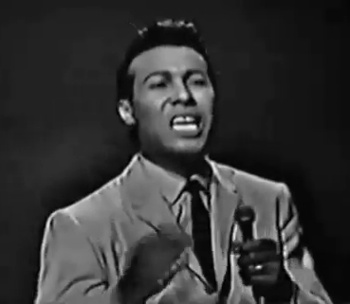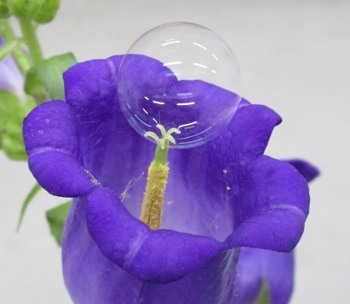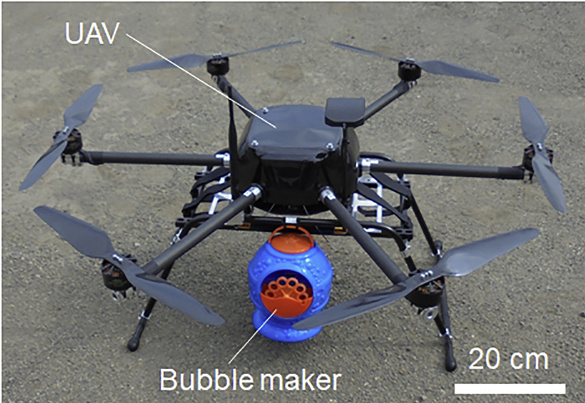Soap Bubble Pollination
August 10, 2020
In the distant past of my
childhood, conversations about
sexual intimacy were rare, and
reproduction was described by a
euphemistic analogy to "
the birds and the bees." Today,
middle school grandchildren know more about
sex than their
grandparents did on their
wedding night, either through
classroom instruction or by the
Internet, the later often giving
too much information.
The "birds and bees" analogy combines the essential parts of sexual reproduction,
birds'
eggs and the
bee's deposit of
fertilizing pollen. The
milieu of my
high school years is captured in the 1964
Jewel Akens song,
The Birds and the Bees.[1] This short (2:08)
record reached the
number three position on the
Billboard Hot 100 chart.

Jewel Akens, singing The Birds and the Bees on Shindig!.
1960s television was replete with popular music shows like Shindig!, Hullabaloo, Hootenanny, and the venerable American Bandstand.
(Screenshot from a YouTube video.)
Short records had an advantage in the era of
Top 40 radio, since
disk jockeys needed to fill their time carefully to accommodate scheduled
news on the hour or half-hour. That's one reason why the 1967 "
The Letter" by the
Box Tops had so much airplay at 1:58, peaking at number on on Billboard.[2] This record reached number one on the Billboard Hot 100. Compare this with the 1968 "
MacArthur Park" by
Richard Harris at 7:21, but still reaching number two on Billboard. Little known fact - Your
scientist author was a Top 40 DJ in the 1960s.
Bees, of course, are associated with
honey.
Beekeeping is a big
business, with an estimated two and a half million
beehives producing about 70
metric tons of honey in the
United States annually. However, the most important function of bees is as
pollinators. The
list of crop plants pollinated by bees is huge, but they're most important in the pollination of the crops listed in the following table.
Honey bees maintained by
commercial beekeepers in the US pollinate
food crops worth about $15 billion annually, and about a third of our food is a consequence of pollination that's mostly done by bees.[3] Pollinator were
celebrated this year during
Pollinator Week, June 22-28, 2020. Pollinator Week was established by a
US Senate resolution in 2006, the same year that beekeepers noticed a marked escalation in what's called
colony collapse disorder (CCD) when nearly all the
worker bees in a honey bee colony disappear. There are many possible causes for CCD, including
pesticides,
pathogens, and effects from
global warming, but no clear
consensus.
.jpg)
Western honey bee (Apis Mellifer).
Few people today have heard the idiomatic expression, "It's the bees knees," which was one of numerous animal-related expressions, such as "the cat's meow," popular in the 1920s. It means "something that's exceedingly wonderful."
The first and only time I heard the "bee's knees" expression was in conversation with the wife of a Manhattan Project scientist. She also liked the expression, "It's all sixes and sevens," meaning "a muddled mess."
(Portion of a Wikimedia Commons image by Ivar Leidus.)
In a one-year span, from April 2019 - April 2020, U.S. beekeepers lost 43.7% of their honey bees.[3] While bee population declines in the
winter, the decline seen in the past winter was actually lower than usual.[3] The big losses happened in
summer, 2019, when beekeepers lost 32% of their bees, a decline that's is 10.4% higher than
average.[3] Beekeepers attribute this decline to
parasitic mites, increased
heat, and possibly, pesticides.[3]
While an
army of
solar-powered microscale robotic drones might replace the pollination provided by honey bee drones, that's not an
economical alternative. The
traditional method for pollination in the absence of bees, done since
antiquity, is to use a
cotton swab, or a small
brush, to apply pollen grains to
flowers.[4-5] An alternative to such time consuming
manual labor is
machine pollination using
blowers,
dusters, or
sprayers, all of which
waste pollen grains by
inefficient targeting.[4] An
artificial pollinator developed in 2017 acted as a bee would by capturing pollen from some flowers with a drone and a
sticky ionic liquid gel for transport to other flowers, but this method caused too much
damage to the
plants.[4-5]
Researchers from the
Japan Advanced Institute of Science and Technology (JAIST) have developed a pollination method in which pollen grains are incorporated into
chemically functionalized soap bubbles delivered by an
autonomous robotic drone.[4-9] The idea for this method of pollination came to the
senior author of the study,
Eijiro Miyako, an
associate professor in the
School of Materials Science at JAIST, while his
son was
blowing soap bubbles in a
park.[6-8] He noticed the bubbles' gently
impacting his son's face from a
toy bubble blower. As he told
BBC News,
"I was playing soap bubbles with my son at a park close to my home, when a soap bubble accidentally hit my son's face... There was no damage because soap bubbles are soft, light, and flexible... But I got an inspiration because I thought the bubbles won't damage the flowers and would be an ideal material for pollination."[8]

A chemically functionalized soap bubble pollinating a campanula flower (Campanula persicifolia).
(Portion of a photo by Eijiro Miyako.)
laboratory testing showed that soap bubbles could carry pollen; however, most soaps are too
toxic for flowers, so a special soap bubbles
mix was developed.[6,8] The selected soap bubble
formulation of a 0.4%
lauramidopropyl betaine had an optimized
pH and added
calcium and
germination supporting
chemicals.[6,9] The soap bubbles held up to 2,000 pollen grains each.[6,9] Pollen activity was observed to be steady three hours after pollination, with the pollen grains growing into
pollen tubes on the
female reproductive part of the flower, the
pistil.[6,7] If a flower was impacted by more than 10 bubbles, the tubes were
shorter than normal, perhaps because of an adverse effect of the bubble solution.[7]
Moving from the laboratory to the
field, the research team was able to pollinate a variety of the
pear tree (
Pyrus pyrifolia) on three trees in an
orchard, and these trees consequently formed pear
fruits sixteen days later at a quantity comparable to hand pollination.[4,7-8] Moving a
technology step further, they used an autonomous,
GPS-controlled drone to direct soap bubbles at
fake lilies, and these bubbles hit their target with 90% success when the drone was moving at two
meters per second.[6,8] Miyako, as quoted by BBC News, said, "In fact, the shape and size of young pear fruits after soap bubble pollination look the same as hand pollination. However our method has more potential advantages in terms of future
automation and reduction of pollen grains."[8]

Image of a robotic pollinator consisting of an unmanned aerial vehicle and a soap bubble maker. (Figure 3d of Reference 4, released under a Creative Commons License.)
Bubbles need much less pollen for pollination than hand pollination with a brush, just 0.06
milligrams per flower compared with 1800 milligrams, so
farmers would need to gather far less pollen.[7] There are a few problems with the soap bubble method, aside from the chemical effect seen when too many bubbles strike a flower.
Raindrops can
wash away the pollen-bearing bubbles, and strong
winds, even the
air flow from the drone
propellers, will blow them away.[6-7,9]
While the soap bubble chemicals used in this study were
biocompatible, they might still build-up in the
environment over time.[4] While bees both collect and deliver pollen, the soap bubbles need a pollen source.[9] Also, some worry that such research might distract from the important task of bee
conservation.[7] This work was primarily
supported by the
Japan Society for the Promotion of Science.[6]
References:
- Jewel Akens, "The Birds And The Bees (1965, Remastered)," YouTube video by Memory Lane, May 8, 2019. Alas, only 3,307 views when accessed.
The Box Tops, "The Letter," YouTube video by Smurfstools Oldies Music Time Machine, Aug 2, 2018. This video had 138,214 views when accessed.
- Richard Harris, "MacArthur Park," YouTube video by gb, August 4, 2013. 3,375,552 views when accessed.
- Dharna Noor, "A Record Number of Bees Died Last Summer," Gizmodo, June 22, 2020.
- Xi Yang and Eijiro Miyako, "Soap Bubble Pollination," Cell, vol. 23, no. 6 (June 26, 2020), Article no. 101188, DOI:https://doi.org/10.1016/j.isci.2020.101188. This is an open access article with a PDF file here.
- Soap bubble pollination is now live!, Japan Advanced Institute of Science and Technology Press Release, June 18, 2020.
- Soap bubbles pollinated a pear orchard without damaging delicate flowers, Cell Press Press Release, June 17, 2020.
- Erik Stokstad, "Drone-delivered soap bubbles could help pollinate flowers," Science, Jun. 17, 2020 doi:10.1126/science.abd3878.
- Blowing bubbles: Soapy spheres pop pollen on fruit trees, BBC News, June 17, 2020.
- Theresa Machemer, "Soap Bubbles Can Pollinate Flowers, but Can They Replace Bees?," Smithsonian Magazine, June 22, 2020.
Linked Keywords: Childhood; sexual relationship; sexual intimacy; sexual reproduction; euphemism; euphemistic; analogy; the birds and the bees; middle school; grandchildren; sex; grandparent; wedding; classroom; education; instruction; Internet; too much information; bird; egg; bee; fertilisation; fertilizing; pollen; social environment; milieu; high school; Jewel Akens; The Birds and the Bees (Jewel Akens song); phonograph record; hierarchy; position; Billboard Hot 100 chart; singing; Shindig!; television; popular music show; Hullabaloo (TV series); Hootenanny (US TV series); American Bandstand; YouTube video; Top 40 radio; disk jockey; radio news; The Letter (Box Tops song); Box Tops; MacArthur Park (song); Richard Harris; scientist author; honey; beekeeping; business; beehive; metric ton; United States; pollinator; crop plants pollinated by bees; Kiwifruit; Brazil Nut; Watermelon; Cantaloupe; Squash, pumpkin, zucchini; Macadamia; Passion Fruit; Rowanberry; Cashew; Starfruit; Turnip, Canola; Coriander; Cucumber; Cardamom; Loquat; Buckwheat; Feijoa; Fennel; Apple; Mango; Avocado; Allspice; Apricot; Prunus avium; Sweet Cherry; Sour Cherry; Prunus; Plum; Almond; Peach, Nectarine; Pear; Rose Hips; Raspberry; Blackberry; Blueberry; commerce; commercial; food crop; celebration; celebrate; United States Senate; resolution (law); colony collapse disorder (CCD); worker bee; pesticide; diseases of the honey bee; pathogen; global warming; scientific consensus; western honey bee (Apis Mellifer); idiom; idiomatic expression; It's the bees knees; animal; the cat's meow; 1920; wife; Manhattan Project; scientist; It's all sixes and seven; Wikimedia Commons; Ivar Leidus; winter; summer; mean; average; parasitism; parasitic; mite; temperature; heat; army; solar energy; solar-powered; micrometer; microscale; robot; robotic; unmanned aerial vehicle; drone; economics; economical; tradition; traditional; antiquity; cotton swab; brush; flower; manual labor; machine; centrifugal fan; blower; feather duster; duster; sprayer; waste; efficiency; inefficient; target; targeting; artificiality; artificial; adhesive; sticky; ionic liquid; gel; damage; plant; research; researchers; Japan Advanced Institute of Science and Technology (JAIST); functionality (chemistry); chemically functionalized; soap bubble; autonomous; author; Eijiro Miyako; associate professor; School of Materials Science at JAIST; son; soap bubble blowing; park; impact (mechanics); impacting; toy; BBC News; home; accident; accidentally; face; lightweight; flexible; material; campanula; flower; Campanula persicifolia; laboratory; evaluation; testing; toxicity; toxic; mixture; mix; formulation; cocamidopropyl betaine; lauramidopropyl betaine; pH; calcium; germination; chemical compound; pollen tube; female; gynoecium; pistil; length; short; field (agriculture); pear; tree; Pyrus pyrifolia; orchard; fruit; technology; Global Positioning System; GPS; artificial lilies; meters per second; automation; Creative Commons License; milligram; farmer; rain; raindrop; washing; wash away; wind; air flow; propeller; biocompatibility; biocompatible; environment (biophysical); conservation (ethic); funding of science; support; Japan Society for the Promotion of Science.